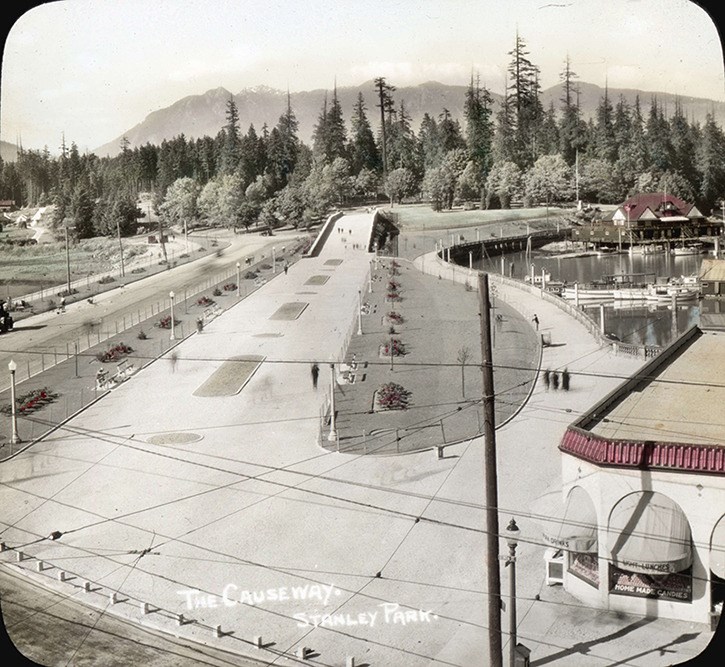Stanley Park history
In 1886, as its first act, Vancouvers newly formed City Council petitioned the federal government to dedicate the land as a park.
Archaeological evidence suggests human activity in the park dating back more than 3,000 years. Historically, the area was the traditional Coast Salish territories of the Musqueam, Squamish, and Tsleil-Waututh First Nations.
Siwash Rock, also known by the Squamish name Slhxi7lsh, stands 50-60 feet tall. In Legends of Vancouver, poet Pauline Johnson relates the Squamish oral history that a man was transformed into this rock by four powerful giants as monument to clean fatherhood.
The Nine OClock Gun is a 12-pound naval cannon cast in England in 1816. It was brought to Stanley Park in 1894 to warn fishermen of the 6pm Sunday close of fishing, and was fired for the first time on Oct. 15, 1898 at noon. The 9pm firing was established later, as a time signal for Vancouverites and ships in port. Previously, the Brockton Point lighthouse keeper, William D. Jones, had detonated a stick of dynamite over the water to similar effect. The cannon was stolen by UBC Engineering students in 1969. The gun also has a Twitter parody account that tweets BOOM! every night at 9pm.
On Sept. 21, 1980, the seawall loop around Stanley Park was declared completed, with the final paving between Third and Second Beach. One-way cycling counterclockwise began in June, 1984.
In December of 2006, a powerful windstorm downed 10,000 trees in the park.

Fast Facts
Stanley Park is a Canadian National Historic Site and covers 1,000 acres of peninsula.
The park sees 8 million visitors per year, and the totem poles at Brockton Point are the most visited tourist attraction in BC.
The park has roughly 500,000 cedar, fir and hemlock trees and produces 18,000 tons of oxygen each year.
The Stanley Park section of the seawall is 8.8km long and takes 2-3 hours to walk, or 1 hour to bike.
Due to an inebriated crew, the S.S. Beaver the first steamship to operate in the Pacific Northwest went aground on rocks at Prospect Point on July 25, 1888, finally sinking in July 1892.
Largest crew working on the seawall at one time: 2,300 in 1920.
Photo: S.S. Beaver | City of Vancouver archives.
New species named after Stanley Park
During the research conducted following the windstorms of 2006, UBCs John McLean led surveys as part of the restoration program to identify insects which had a special appetite for wood. This work ultimately led to the discovery of two new species of insects, one of which was named after the park itself. Oxypoda stanleyi is a tiny member of the rove beetle family, found in fair numbers in the park at both the Aquarium and Hollow Tree sites.

The Seawalls enduring legacy
The majority of the Stanley Park portion of the wall was built between 1914 and 1971. The idea was conceived to stop foreshore erosion from the wake of ships passing through First Narrows.
James Cunningham, a Park Board master stonemason, spent 32 years on the project until his death in 1963, and oversaw much the construction of the original wall.
Cunningham continued supervising the project into his final days, despite being ill, and, on at least one occasion, went to check the seawalls progress still wearing pajamas.
He passed away 17 years before the wall was completed, but continues to be the person most associated with the project. A plaque commemorating Cunninghams work can be seen in the rock face above the seawall at Siwash Rock, where his ashes were scattered.
Files compiled by Kelsey Klassen. Sources include SPES, Vancouver Park Board and Wikipedia.
It's all about Stanley Park this weekend. Want to know more?
Celebrate! Stanley Park events: http://www.wevancouver.com/news/220730601.html
Lost art of Stanley Park: http://www.wevancouver.com/news/220733111.html
Counting critters with BioBlitz: http://www.wevancouver.com/news/220733751.html
Tourism Vancouver's Top 5: http://www.wevancouver.com/news/220734001.html
Inventing Stanley Park: http://www.wevancouver.com/news/220734291.html



